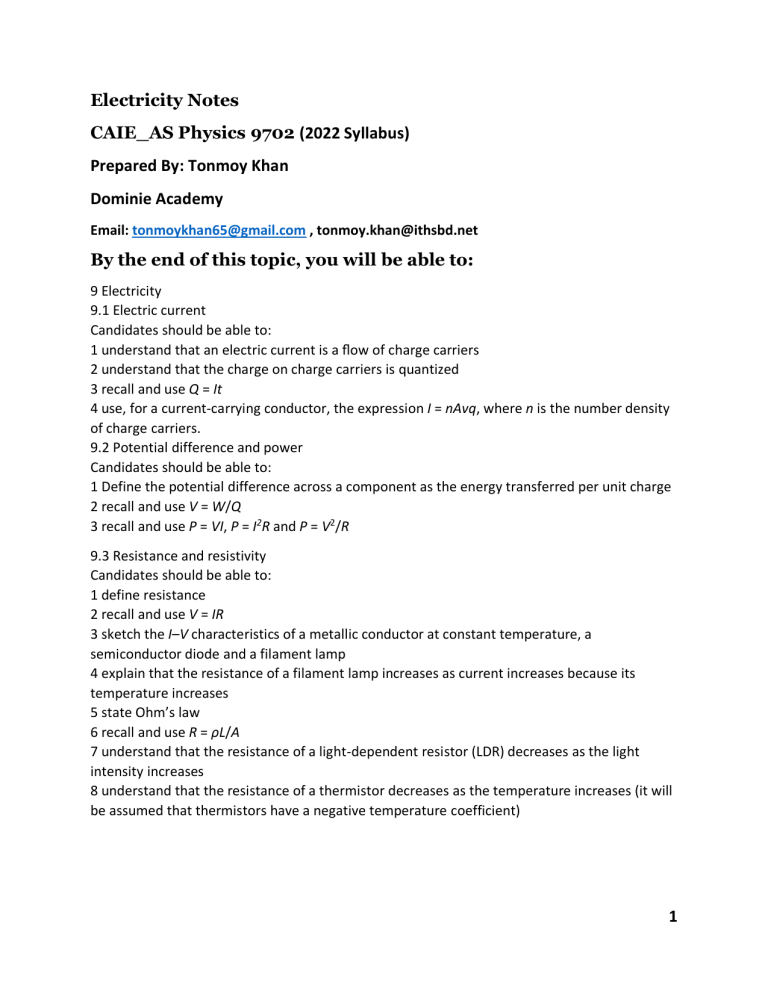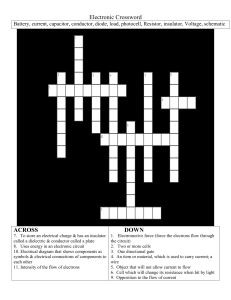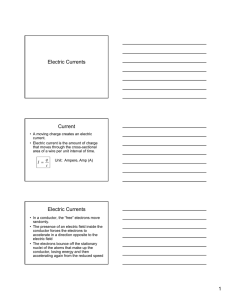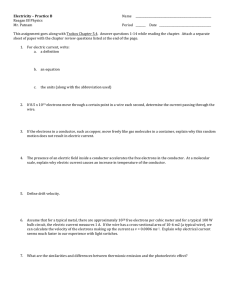
Electricity Notes CAIE_AS Physics 9702 (2022 Syllabus) Prepared By: Tonmoy Khan Dominie Academy Email: tonmoykhan65@gmail.com , tonmoy.khan@ithsbd.net By the end of this topic, you will be able to: 9 Electricity 9.1 Electric current Candidates should be able to: 1 understand that an electric current is a flow of charge carriers 2 understand that the charge on charge carriers is quantized 3 recall and use Q = It 4 use, for a current-carrying conductor, the expression I = nAvq, where n is the number density of charge carriers. 9.2 Potential difference and power Candidates should be able to: 1 Define the potential difference across a component as the energy transferred per unit charge 2 recall and use V = W/Q 3 recall and use P = VI, P = I2R and P = V2/R 9.3 Resistance and resistivity Candidates should be able to: 1 define resistance 2 recall and use V = IR 3 sketch the I–V characteristics of a metallic conductor at constant temperature, a semiconductor diode and a filament lamp 4 explain that the resistance of a filament lamp increases as current increases because its temperature increases 5 state Ohm’s law 6 recall and use R = ρL/A 7 understand that the resistance of a light-dependent resistor (LDR) decreases as the light intensity increases 8 understand that the resistance of a thermistor decreases as the temperature increases (it will be assumed that thermistors have a negative temperature coefficient) 1 Charge and current: Electric Current is defined as the rate of flow of electric charge past a point. From the definition, the relationship between charge, current and time may be written as: current = charge/time. The equation for current can be rearranged to give an equation for charge: Charge (C) = current (A) × time (s) Q=It One coulomb is the charge which flows past a point in a circuit in a time of 1s when the current is 1A. Coulomb (C) is the S.I unit of charge. • In metals, the charge carriers are conducting free electrons. • In electrolyte, the charge is carried by the flow of positive and negative ions. Any charged particles which contribute to an electric current are known as charge carriers; these can be electrons, protons or ions. Quantization of Charge • The charge-on-charge carriers is quantized • Charge comes in definite bits – e.g. a single proton has a single positive charge, whereas a single electron has a single negative charge • In this way, the quantity of charge can be quantized dependent on how many protons or electrons are present – positive and negative charge has a definite minimum magnitude and always comes in multiples of that magnitude • This means that if we say something has a given charge, the charge is always a multiple of the charge of an electron by convention o The charge of an electron is -1.60 × 10-19 C 2 o The charge of a proton by comparison is 1.60 × 10-19 C (this is known as the elementary charge, denoted by e and measured in Coulombs (C). So, charge quantization means that charge cannot take any arbitrary values, but only values that are integral multiples of the fundamental charge (charge of proton/electron). Conventional Current Flow Direction Electrons always flow from a negatively charged to a positively charged end. This is the electron flow direction. Now coming to the convectional current, in the previous days it was assumed that current flows from positive to negative end and it is widely held today. This is called the convectional current flow. In circuit diagram, you’ll usually be given with conventional current direction. The diagram below makes it clearer. Measuring Current: An analog or digital ammeter is used to measure current. Ammeters should always be connected in series with the part of the circuit you wish to measure the current through. The primary difference between the two is the display, an analog ammeter uses a needle to show the value, while a digital ammeter will show the results as numbers on a screen. 3 Deriving I = Anvq I = current (amps, A) v = drift velocity (m/s) A = cross-sectional area of the conductor (m2) n = charge density (m-3). number of charge carrier per unit volume q = charge on each charge carrier (coulombs, C) In the time t, all of the electrons in the length l of wire have emerged from the wire. We can calculate how many electrons this is, and hence the charge that has flowed in time t: number of electrons = number density × volume of wire = n × A × l Total charge of electrons = number × electron charge = n × A × l × q We can find the current I because we know that this is the charge that flows in time t, and current = charge/time: I=n×A×q×l/t Substituting v for l/t gives: I = nAqv Factors affecting drift velocity: Figure 9.10 shows how the mean drift velocity of electrons varies in different situations. We can understand this using the equation: v = I/(nAq). • If the current increases, the drift velocity v must increase. That is: v ∝ I. 4 • If the wire is thinner, the electrons has to move more quickly for a given current. There are fewer electrons in a thinner piece of wire, so an individual electron must travel more quickly. That is: v ∝ 1/A • In a material with a lower density of electrons (smaller n), the mean drift velocity must be greater for a given current. That is: v ∝ 1/n Potential Difference: Potential difference between any two point in a circuit is a measure of electrical energy transferred, or the work done, by each coulomb of charge as it moves from one point to the other. 𝑷𝒐𝒕𝒆𝒏𝒕𝒊𝒂𝒍 𝒅𝒊𝒇𝒇𝒆𝒓𝒆𝒏𝒄𝒆 = 𝒆𝒏𝒆𝒓𝒈𝒚 𝒕𝒓𝒂𝒏𝒔𝒇𝒆𝒓𝒓𝒆𝒅 [𝒇𝒓𝒐𝒎 𝒆𝒍𝒆𝒄𝒕𝒓𝒊𝒄𝒂𝒍 𝒕𝒐 𝒐𝒕𝒉𝒆𝒓 𝒇𝒐𝒓𝒎𝒔] (𝒐𝒓 𝒘𝒐𝒓𝒌 𝒅𝒐𝒏𝒆) 𝑪𝒉𝒂𝒓𝒈𝒆 𝑽= 𝑾 𝑸 Therefore, W=VQ Unit of potential difference is Volt (V) The potential difference across two points in a circuit is 1 volt if 1 joule of work is done in moving 1 coulomb of charge from one point to the other. 1 Volt= 1 joule per coulomb. 5 Electrical resistance Electrical resistance of any component is defined as the ratio of the potential difference to the current. resistance = potential difference/ current Or, R = V/I The unit of resistance is ohm (Ω) The ohm is equivalent to ‘1 volt per ampere’. That is: 1Ω = 1VA−1 Electrical power The rate at which energy is transferred is known as power. power = energy transferred/time taken P = W/∆t The amount of energy W transferred by a charge ∆Q when it moves through a potential difference V is given by: W = V∆Q Hence: P = W/∆t = V∆Q/∆t = V (∆Q/∆t) The ratio of charge to time, ∆Q/∆t, is the current I in the component. Therefore: P = VI The p.d. V across the resistor is given by V = IR. Combining this with the equation for power, P = VI, gives us two further forms of the equation for power dissipated in the resistor: P = I2R P = V2/R Ohm’s Law: The current through a metallic conductor is proportional to the potential difference across the conductor provided the temperature remains constant. 6 Resistivity At a constant temperature, the resistance is directly proportional to the length of the wire and inversely proportional to its cross-sectional area. That is: resistance ∝ length and resistance ∝ 1/cross-sectional area Combining the two proportionalities for length and cross-sectional area, we get: resistance ∝ length/cross-sectional area or R ∝ L/A R= ρL/A Therefore, ρ=(R*A)/L The electrical resistivity is the electrical resistance per unit length and per unit of cross-sectional area at a specified temperature. The SI unit of electrical resistivity is the ohm⋅metre (Ω⋅m). Resistivity ρ is an intrinsic property of a material, independent of its shape or size. In contrast, the resistance R is an extrinsic property that does depend on the size and shape of the resistor. I–V characteristics of a metallic conductor at constant temperature The I-V graph of metallic conductor is a straight-line pass through the origin. They obey Ohm’s Law. Reason: Resistance in metal is the reduction of the drift velocity of electrons due to collision with the lattice ions. If the temperature of the 7 conductor is kept constant, the magnitude of the vibration of the lattice ions remain the same, and hence it’s resistance would remain the same. I–V characteristics of a semiconductor diode: A diode is made of semiconducting material. The circuit symbol for a diode is shown in Figure below. The diode conducts when the conventional current is in the direction of the arrowhead symbol. This condition is called forward bias. In this case, the potential on the left-hand side of the diode is more positive than the potential on the right-hand side. When the voltage is reversed, the diode is said to be in reverse bias. The diode does not conduct in reverse bias. Figure: Circuit Symbol of Diode When forward-biased, the diode's resistance is very large up-to the threshold voltage (which is the smallest voltage needed to allow current to flow in the diode). But, above threshold voltage, the resistance quickly drops and current begins to flow. Diode is used in rectifier circuit to convert a.c to dc. 8 Filament lamp: This component contains a length of metal wire, which heats up as current increases, therefore the resistance of this component increases as current increases. At low currents the metal wire will not heat up significantly therefore for very low currents, Ohm’s law is obeyed. However, as the current increases (in either direction), the graph begins to curve due to the increasing resistance. Effect of Temperature on metal conductor: The resistance of a metal conductor is due to collisions between the free electrons of the electric current and the metal ions of the wire. If the temperature of a metal conductor increases, the ions of the metal vibrate more vigorously. This increases the number of collisions between the free electrons and the ions and so the resistance increases. Effect of Temperature on Thermistor: When temperature is increased, more electrons can break free from the atoms and participate in conduction. That means that n increases, so current I increases, the resistance decreases. Remarks: In fact, there are two effects if temperature increases: 1) increase of vibration of atoms, which leads to the increase of resistance; 9 2) increase of free electron density n, which leads to the decrease of resistance. For semiconductor materials, no. of free electrons are very small. When temperature is increased, effect 1 is small and effect 2 is significant. So, the overall result is the decrease of resistance when temperature is increased. The Light-Dependent Resistor (LDR) In a light-dependent resistor the resistance decreases as the light intensity (brightness of light) increases. It has the symbol: • At low light levels or in the dark the resistance of an LDR is high and little current flows through it. • In bright light the resistance of an LDR is low and more current flows through it. The properties of an LDR are put to use in digital camera. The shutter speed of a camera can be controlled by an LDR. If light levels are low changes in the resistance of the LDR can be measured causing the shutter to stay open for longer. An LDR can also be used in a burglar alarm circuit for e.g. inside a safe. When the safe is closed it is dark and 10 so the resistance of the LDR is high. If it is opened and the LDR exposed to light the resistance drops allowing current to flow which can then trigger a relay circuit which rings an alarm. How an LDR works? An LDR or photoresistor is made any semiconductor material with a high resistance. It has a high resistance because there are very few electrons that are free and able to move - the vast majority of the electrons are locked into the crystal lattice and unable to move. Therefore, in this state there is a high LDR resistance. As light falls on the semiconductor, it releases electrons which increases the number of electrons to carry the current. This results in a lowering of the resistance of the semiconductor and hence the overall LDR resistance. Electricity Notes CAIE_AS Physics 9702 (2022 Syllabus) Prepared By: Tonmoy Khan Dominie Academy Email: tonmoykhan65@gmail.com , tonmoy.khan@ithsbd.net 11






